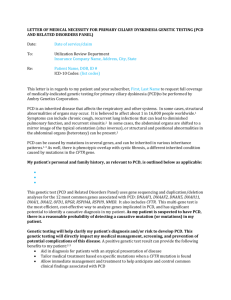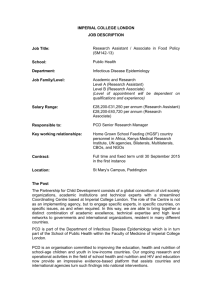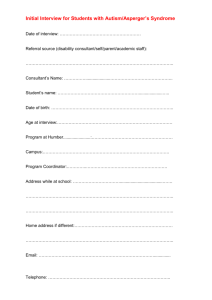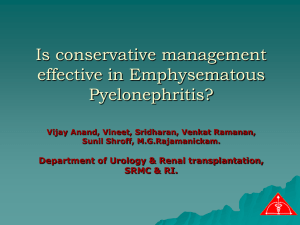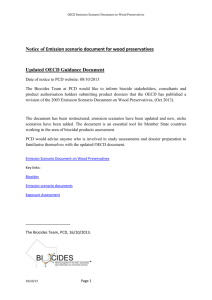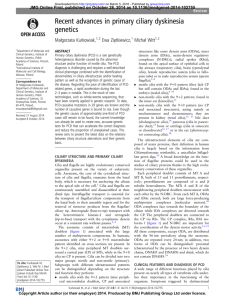DIAGNOSIS AND MANAGEMENT OF CILIOPATHIES
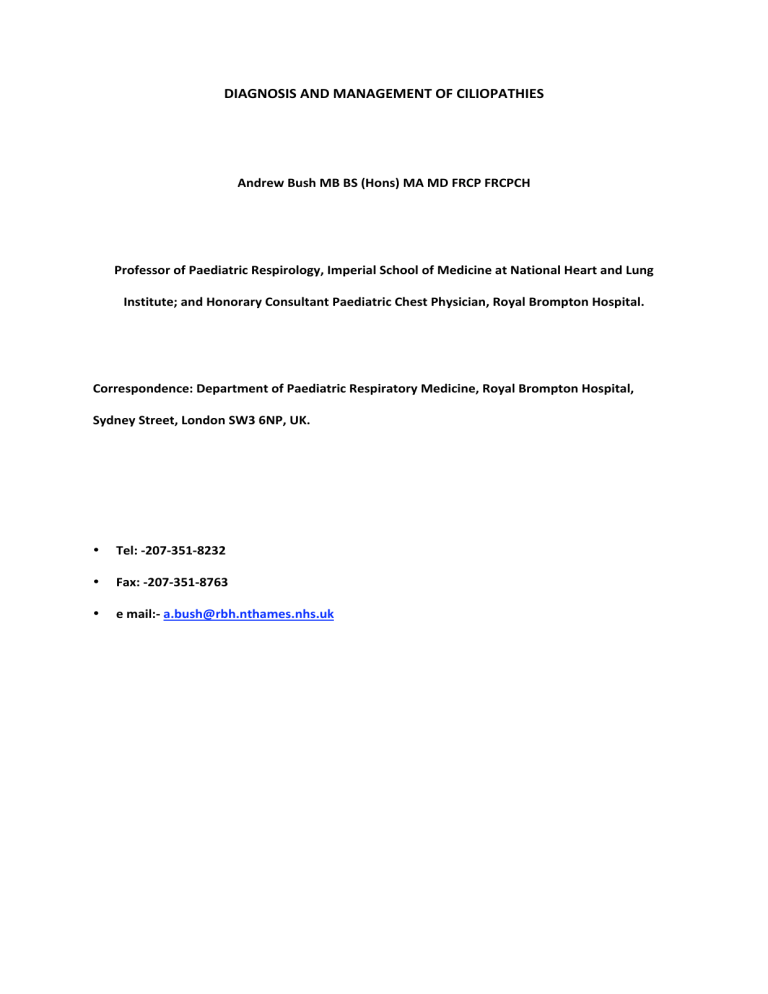
DIAGNOSIS AND MANAGEMENT OF CILIOPATHIES
Andrew Bush MB BS (Hons) MA MD FRCP FRCPCH
Professor of Paediatric Respirology, Imperial School of Medicine at National Heart and Lung
Institute; and Honorary Consultant Paediatric Chest Physician, Royal Brompton Hospital.
Correspondence: Department of Paediatric Respiratory Medicine, Royal Brompton Hospital,
Sydney Street, London SW3 6NP, UK.
•
Tel: ‐207‐351‐8232
•
Fax: ‐207‐351‐8763
• e mail:‐ a.bush@rbh.nthames.nhs.uk
Introduction
If Nitric oxide (NO) was the molecule of the 1990s, cilia are the organelles of the 21 st century. There has been an explosion of knowledge in the understanding of the disparate functions of cilia, and of disease caused by their dysfunction. This presentation will discuss the spectrum of ciliopathy, but focus mainly on the diagnosis and management of primary ciliary dyskinesia (PCD). Most of the other ciliopathies are the province of non‐respiratory paediatricians.
There are three groups of mammalian cilia:
•
Primary cilia : (which are NOT abnormal in PCD) have 9 outer doublets, no central pair, and are probably non‐motile. There is only one per cell, they are found on many cell types, and probably function as chemo‐, osmo‐ and phototransduction sensors
•
Nodal cilia : These are primary in structure, but motile with a circular, rotator beat. They are found in the embryonic node and determine organ situs
•
Motile cilia : These have the classic 9+2 structure, and are responsible for propelling mucus along epithelial surfaces (or propelling single cell organisms through liquid). There are around 200/respiratory epithelial cell.
Ciliary assembly includes complex intraflagellar transport, including retrograde recycling of proteins.
The process involves at least eight Bardet‐Biedl‐Syndrome (BBS) proteins. Ciliary signal transduction involves the hedgehog signaling pathway, and canoniocal and non‐canonical Wnt pathways.
The extended spectrum of ciliopathy
Syndromic Manifestations : Mutations in more than 40 genes have been associated with ciliopathy.
Many are complex, overlapping genetic disorders, and each syndrome may be related to many different underlying mutations, some of which have been identified as part of the ciliosome [1]. The more important are listed below.
•
Joubert syndrome (JBTS) : is characterized by hypotonia, ataxia, psychomotor delay, irregular breathing pattern, oculomotor apraxia with cerebellar and brainstem abnormalities
•
Meckel‐Gruber syndrome (MKS) : overlaps with JBTS. Features include posterior fossa defects, cystic dysplastic kidneys, hepatic duct proliferation and polydactyly.
•
Senior‐Loken syndrome (SLS) : is characterized mainly retinal disease (retinitis pigmentosa
(RP) and congenital blindness, and renal disease (nephronophthisis, polycystic disease and cystic renal dysplasia)
•
Orofacial digital syndrome (OFD) : is characterized by oral cavity, facial and digital malformations, cystic kidney disease and central nervous system abnormalities
•
Leber’s congenital amaurosis (LCA) : this early presenting syndrome is characterized by poor visual function, often with nystagmus and reduced or absent papillary responses, photophobia, keratoconus and hyperopia.
•
Bardet‐Biedl‐Syndrome (BBS) : This syndrome includes rod‐cone dystrophy, polydactyly, obesity, learning disabilities, hypogonadism and renal disease (renal dysplasia, cystic tubular
disease, nephronophthisis, focal glomerular sclerosis), and detrusor instability. Among the many secondary features are speech disorders, developmental delay and behavioural disorders, strabismus, cataracts and astigmatism, brachydactyky or syndactyly, ataxia and poor coordination, hypertonia, anosmia, diabetes, fibrocystic liver disease, Hirschsprung’s disease, cardiovascular abnormalities and sometimes craniofacial abnormalities
(brachycephaly, bi‐temporal narrowing, male frontal balding, large ears, a short and shallow philtrum, nasal anomalies, mid‐facial hypoplasia and mild retrognathia
•
Alstrom’s syndrome (ALS) : is characterized by cone‐rod dystrophy, obesity, sensorineural hearing loss, dilated cardiomyopathy (60% develop cardiac failure), insulin resistance syndrome and developmental delay. Males have hypogonadism. Renal failure may be early, but unlike in BBS, cognitive function is relatively preserved and there are no digital anomalies
•
Jeune asphyxiating thoracic dystrophy (JATD) : this syndrome falls within the province of paediatric respirology, because mild cases may have prolonged survival, and severe cases are doing better with thoracic expansion procedures. The characteristic skeletal findins are a very narrow thorax with short ribs; hypoplastic ileal wings, trident acetabular roofs and rhizomelic limb shortening. Diagnosis can be made by a skilled paediatric bone radiologist from the radiological appearances, including irregular metaphysical ends. There may be post‐axial polydactyly, brachydactyly, hydrocephalus, retinitis pigmentosa and retinal aplasia, glomerulosclerosis and cystic renal disease including nephronopophthisis, and pancreatic and hepatic fibrocystic disease. A case of intestinal malrotation and disordered motility in jeune’s syndrome has recently been reported [2]. JATD is genetically heterogeneous, but cases with mutations in IFT80 , which is important in intraflagella transport have been described, and abnormal sonic hedgehog signaling has been implicated.
•
Ellis van Creveld syndrome (EvC) : this can be confused with JATD, but can be distibguished by the nail dysplasia and the appearances of the upper lip. 60% have heart defects, wich are rare in JATD. EvC is characterized by short limbs and ribs, post‐axial polydactyly and dysplastic nails and teeth. The Evc protein localizes to the base of cilia.
•
Sensenbrenner syndrome (cranioectodermal dysplasia) : This is similar to EvC, but has the additional features of renal cysts with dolicocephaly, sparse and slow‐growing hair, epicanthal folds, disorders of dentition, brachycephaly and a narrow thorax.
Organ‐specific Manifestations : Single or multiple organ disease, not part of a syndrome, is part of ciliopathy. Kindreds have been described in which several different single organ manifestations of ciliopathy have been manifest.
•
Congenital heart disease : Complex congenital heart disease, especially with disorders of laterality have an increased prevalence in PCD. Children with these abnormalities should be carefully screened for PCD.
•
Renal disease : The best known is polycystic kidney disease (PKD), which can be associated with liver cysts, and may present in childhood as well as adult life. Disease is due to mutations in polycystin 1 or 2. Interestingly, polycystin 1 is expressed in respiratory epithelium [3], and there is a higher than expected prevalence of bronchiectasis is non‐PKD renal disease. Nephronophthisis presents with childhood renal failure, and imaging shows
normal kidney size with loss of cortico‐medullary differentiation and increased echogenicity.
More than 10% have extrarenal features, incuding retinal disease, fibrocystic liver disease, skeletal dysplasias and hypoplasia of the cerebellar vermis. Renal dysplasia is characterized by small kidneys, unilateral or bilateral. The kidneys have increased echogenicity and small subcapsular cysts.
•
Liver disease : these are heterogeneous. Congenital fibrocystic diseases of the liver are characterized by any of congenital hepatic fibrosis, bile duct dilatation and cyst formation.
•
Retinal disease : Disorders of retinal photoreceptors manifesting as a progressive loss of peripheral vision. Retinitis pigmentosa ia a common ophthalmoscopic appearance.
PRIMARY CILIARY DYSKINESIA
Classical PCD is a disease of the upper and lower respiratory tracts, with associated mirror image arrangement in nearly half of all cases. Extended kindreds with PCD and other ciliopathies such as retinitis pigmentosa have been described.
When to suspect PCD
Many symptoms are very non‐specific, and the key is to maintain a high index of suspicion, and take a really focused history [4].
•
Antenatally : Diagnosis of abnormal situs or complex congenital heart disease
•
Newborn period : Rhinorrhea from birth, respiratory distress with no obvious cause; abnormal situs; complex congenital heart disease; testing because of a positive family history
•
Childhood : Chronic productive cough (which should be differentiated from recurrent acute cough, which is usually normal in childhood), atypical ‘asthma’ not responding to treatment,
‘idiopathic’ bronchiectasis, rhinosinusitis, and severe otitis media with effusion, especially with prolonged otorrhea after tympanostomy tube insertion.
•
Adulthood : As for childhood, and also immotile sperm leading to male infertility; ectopic pregnancy.
•
With a personal or family history of an associated (ciliopathy) diagnosis : Complex congenital heart disease, biliary atresia, polycystic kidney or liver disease, hydrocephalus, retinitis pigmentosa and severe oesophageal disease should all prompt consideration of PCD as part of the spectrum
Diagnosis of PCD
PCD must be distinguished from secondary ciliary abnormalities caused by viral infection or pollution, for example. Since so many symptoms of PCD (cough, rhinitis) are very non‐specific, it is essential that the diagnosis is confirmed in a centre with expertise in testing. If there is doubt, testing should be repeated after a time interval.
•
Screening tests : Nasal NO is very low in PCD, but also in other conditions. A high nNO with a low risk history virtually excludes the diagnosis. There is only scant information on this test in infants, so results should be interpreted cautiously. Other screening tests include radio‐ isotope clearance and the saccharin test, which last is very difficult to interpret in children
•
Tests of ciliary motility : Ciliated epithelium is obtained by nasal brush biopsy. Ciliary beating should be recorded digitally, and beat frequency and pattern noted.
•
Ciliary structure : this is determined by transmission electron microscopy, sometimes with computerized edge enhancement. Note that undoubted cases of PCD with normal ultrastructure have been reported.
•
Ciliary culture : This is only needed in cases of doubt. If ciliated epithelium is regrown in culture, secondary ciliary defects disappear, whereas primary abnormalities persist and can be identified by motility studies and electron microscopy.
•
Genetic studies : The ciliary proteosome contains over 1000 polypeptides, and there is presumably an elaborate assembly apparatus, so numerous genes can likely cause PCD, of which fewer than 20 have been identified. Hence genetic studies may occasionally confirm a doubtful diagnosis, they cannot be used to exclude one.
Management of PCD
There are no worthwhile randomized controlled trials of treatment, protocols are highly variable, and either empirical or based on cystic fibrosis (CF) [4]. These have been reviewed recently [refs]. It is recommended that children are seen in a dedicated PCD clinic, with full facilities for monitoring lung function and hearing
•
Lower respiratory manifestations : airway clearance is encouraged with chest physiotherapy and exercise. Antibiotics are prescribed for positive cultures, and given continuously if there are repeated isolates of a particular organism. If Pseudomonas aeruginosa is isolated, then eradication regimes are as for CF. If the child is thought also to have coincident asthma, then inhaled corticosteroids and bronchodilators are published. The use of anti‐inflammatory and mucolytic agents such as rhDNase is based on isolated reports.
•
Upper respiratory manifestations : in general, conservative management is best. Chronic secretory otitis media tends to improve with age, and tympanostomy tubes should be avoided. Functional endoscopic sinus surgery may be rarely needed. Chronically discharging ears are almost invariably infected with Pseudomonas aeruginosa , and are treated with ciprofloxacin eardrops
•
Other manifestations : Male adults may need assisted conception service, and itracytoplasmic sperm injection (ICSI) should be offered. Management of associated diagnoses is beyond the scope of this article.
Prognosis of PCD
Unfortunately, diagnosis of PCD is frequently delayed until well after bronchiectasis has developed.
Although in many patients lung function can be stabilized, a recent report suggests as many as a
third may show deterioration in lung function [5], and some PCD patients have had to undergo lung transplantation
Learning points
1.
Ciliary dysfunction is implicated in an ever‐widening spectrum of disease
2.
Children with complex congenital heart disease with disorders of laterality should have the diagnosis of PCD considered as a serious possibility.
3.
There is a higher than expected prevalence of bronchiectasis in renal disease – beware the kidney patient with a cough!
4.
There needs to be a high level of suspicion for the diagnosis of PCD in many contexts, otherwise diagnosis will be delayed until after the onset of bronchiectasis.
References
1.
Waters AE, Beales PL. Ciliopathies: an expanding disease spectrum. Pediatr Nephrol epub
2.
Hall T, Bush A, Fell J, Offiah A, Smith V, Abel R. Ciliopathy spectrum expanded? Jeune syndrome associated with foregut dysmotility and malrotation. Pediatr Pulmonol. 2009; 44:
198‐201.
3.
Driscoll JA, Bhalla S, Liapis H, Ibricevic A, Brody SL. Autosomal dominant polycystic kidney disease is associated with an increased prevalence of radiographic bronchiectasis. Chest.
2008; 133: 1181‐8.
4.
Bush A, Chodhari R, Collins N, Copeland F, Hall P, Harcourt J, et al. Primary ciliary dyskinesia: current state of the art. Arch Dis Child. 2007; 92: 1136‐40
5.
Marthin JK, Petersen N, Skovgaard LT, Nielsen KG. Lung function in patients with primary ciliary dyskinesia: a cross‐sectional and 3‐decade longitudinal study. Am J
Respir Crit Care Med. 2010; 181: 1262‐8.
